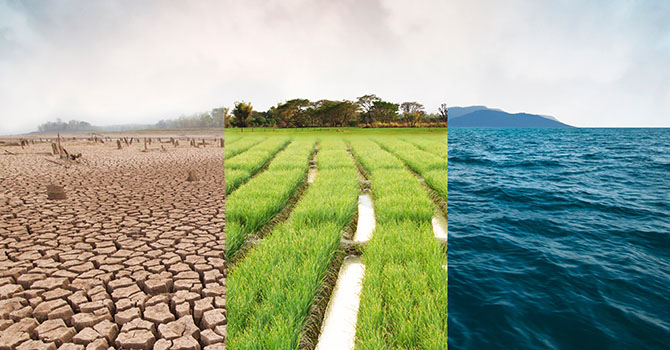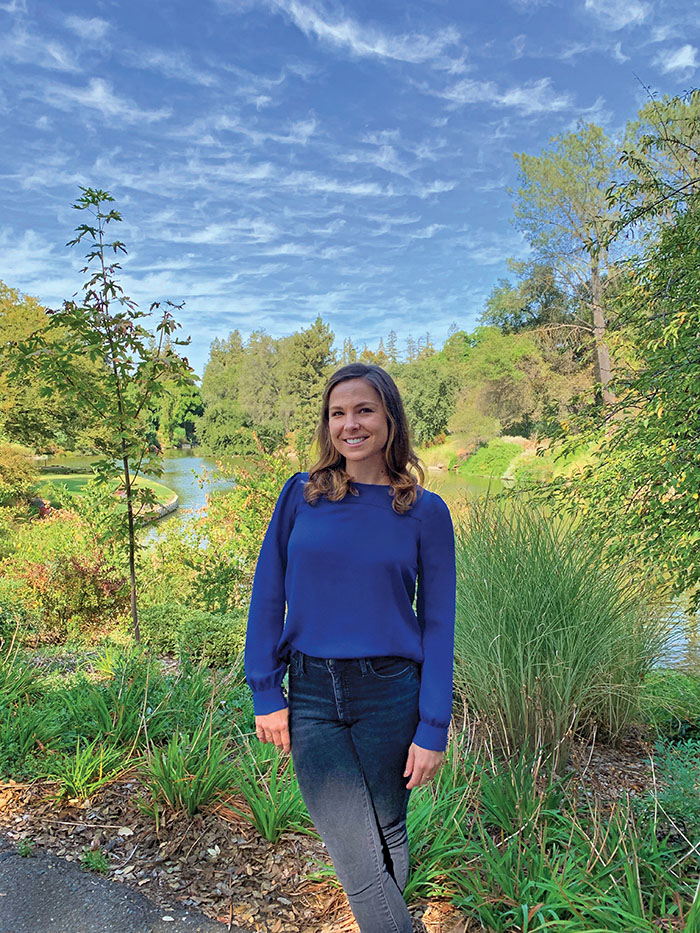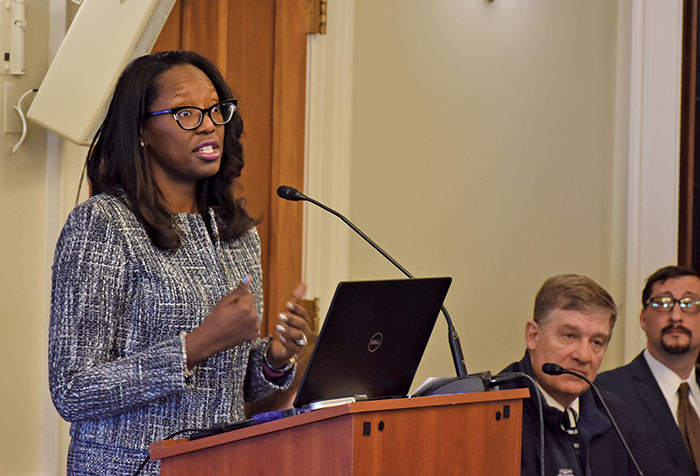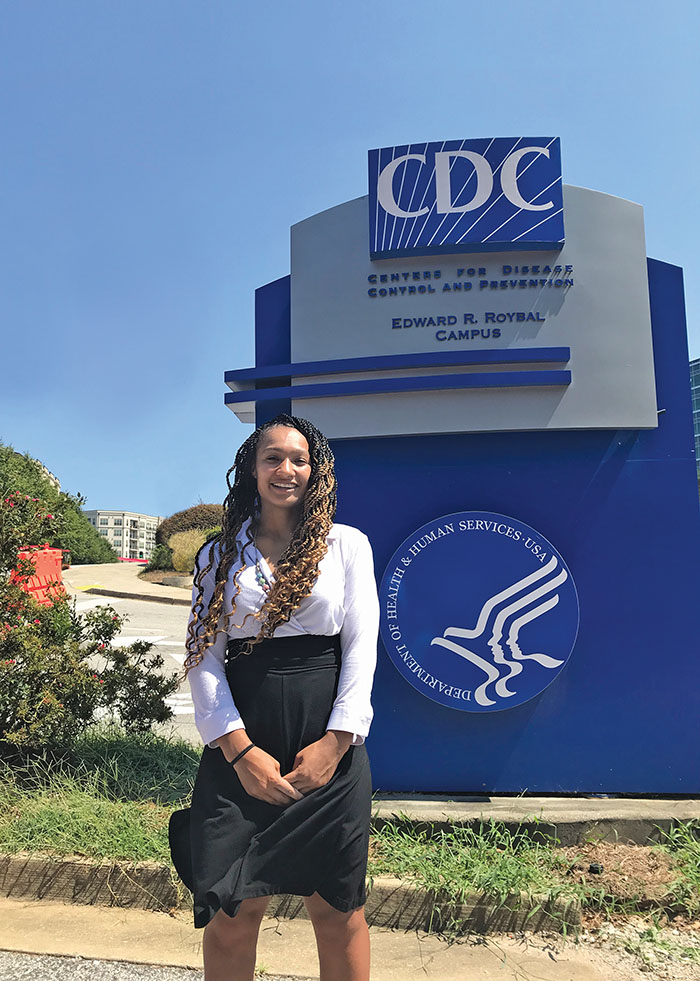Stretching the Field: Public Health's New Generation of Climate Change Professionals

Public health practitioners are increasingly aware of the pressures climate change places on their work—from flooding, drought, and heatwaves to policy and health management to the unknown of a dynamic environment.
“Climate and health interventions are happening more and more because they have to,” says Kathryn Conlon, BA ’05, PhD ’13. “Climate change is real, and severe weather isn’t going away anytime soon.”
Before becoming assistant professor of public health sciences and veterinary medicine at University of California-Davis, Conlon spent six years as an epidemiologist with the Centers for Disease Control (CDC). For two of those years, she was deployed at the National Center for Atmospheric Research in Boulder, Colorado, learning how to leverage climate models to inform public health practice.

Climate change adaptation and disaster preparedness are very closely related, and public health excels at interdisciplinary thinking . . . not only between researchers but broadly across public health practice.
—Kathryn Conlon, BA ’05, PhD ’13
Conlon researches fine-scale vulnerability, developing methods to demonstrate which subpopulations are at higher risk during extreme weather events. “We can prioritize these locations in preparing for future events and providing support during the event. Human populations have limited resources to address these events. Public health responds quickly, but the science on climate and health-intervention effectiveness needs to be a priority. We need better methods for saying what works and what doesn’t to protect populations from climate extremes,” she says.
Climate change is stretching public health, which is a relatively new player both to formal disaster response and to climate science. But Conlon knows that public health is good at stretching. “We’re diving into science that is not traditionally public health to look at weather maps and climate models and to layer those onto small-scale, population-oriented, localized interventions and preparations. Climate change adaptation and disaster preparedness are very closely related,” she says, “and public health excels at interdisciplinary thinking, which will have to be on full display in addressing climate change, not only between researchers but broadly across public health practice.”
Coordination and Communication
“How many of our practitioners fully understand the impacts of climate change?” asks Jalonne White-Newsome, PhD ’11, senior program officer at the Kresge Foundation in Detroit. “How many of our practitioners are skilled at integrating preparedness into the everyday essential services a local public health department provides?”
The assumption, at the moment, is not many.
White-Newsome provides leadership for the Kresge Foundation’s Climate Resilient and Equitable Water Systems (CREWS) initiative and the Climate Change, Health, and Equity (CCHE) initiative, which provides grants to organizations across the country to build communities more resilient to the impacts of climate change, particularly urban flooding and health. “We practitioners have a crucial role at this intersection of climate change and public health,” she says. “Whether you’re a local public health official, a nurse or physician, a field scientist, a first responder—we have to prepare the public for everything climate change might throw at us. We have a long way to go, but funding local organizations directly is an efficient, expeditious way to do local climate resilience and intervention work.”

If we don’t put people and public health first in all policies, we will continue repeating the same mistake, magnifying these already existing health disparities.
—Jalonne White-Newsome, PhD ’11
White-Newsome’s team includes experts on climate change mitigation, adaptation, resiliency, and policy. Each year, grantees from across the US convene to develop creative approaches to the many institutional and structural changes needed to better prepare, plan, and respond to disasters. “It is inspiring to see water-utility managers working with environmental justice organizations and scientists and learning from each other,” she says.
Preparing for the Unknown
Formal cross-sector partnerships might be the only path to preparing adequately for climate realities we cannot fully predict. Even when we know flooding or heatwaves are likely to occur in a certain region, the timing and severity of those events are difficult to discern until they are happening. In these circumstances, real-time data and communication is vital.
“The role of disaster epidemiology is to get the right information to the right people at the right time,” says Jacqueline Cardoza, MPH ’18, a fellow for the CDC’s National Center for Environmental Health, which supports capacity building among public health practitioners in using disaster epidemiology tools.
“One of the biggest challenges in emergency response is the unknown nature of most disasters. We rarely have as much baseline information as needed, and there are competing priorities to navigate as additional partners get involved,” Cardoza says. “Making decisions on partial or limited information is never ideal, but it’s usually the reality, and traditional public health disciplines like biostatistics and epidemiology know how to develop viable, evidence-based solutions even when data is incomplete.”
Cardoza coordinates the CDC’s Disaster Epidemiology Community of Practice—a collaboration across federal and state agencies that provides resources to partners to increase use of disaster surveillance tools and improve situational awareness and response training.
Just as White-Newsome emphasizes coordination in preparing for disasters, Cardoza sees role clarity and communicating expectations as central to operating well in the middle of a disaster. “First responders and emergency managers have experience-based training to assist people in need. Public health practitioners are trained to analyze population data and see problems holistically. If we can train practitioners together so that they understand each other’s—and thus their own—roles better, and if we can standardize disaster surveillance practices across state, local, territorial, and tribal levels, we can ensure better, more equitable responses to the unpredictable effects of disasters,” she says.
Equity and Policy
Disasters exacerbate problems that existed before the storm, before the heatwave or the flooding, including poverty, lack of affordable housing, low employment, and unequal access to health care. “Vulnerable populations might have a harder time recovering and might never fully recover from the effects of a disaster,” says Cardoza.

Creating safer, more resilient communities can come from environmental design, neighborhood watch communities, or community events that bring the community together.”
—Jacqueline Cardoza, MPH ’18
Cardoza says we must build safer, more resilient communities now. “People afraid of theft might be concerned about leaving their homes and following evacuation orders during a flood or going to cooling stations during heatwaves. People with injuries or chronic illness might need additional care during disasters,” she explains. “Creating safer, more resilient communities can come from environmental design, neighborhood watch communities, or community events that bring the community together,” all of which come from planning and organizing today rather than trying to build communities back up after disasters.
Before joining the Kresge Foundation, White-Newsome served as director of federal policy for WE ACT—an environmental justice organization that began in New York City’s West Harlem neighborhood in response to environmental racism—working to integrate into federal policy the concerns of low-income communities and communities of color. “How many times have we heard that the poor, the people of color, did not receive relief and adequate care in an emergency, or did not receive it in a timely fashion? Far too often.”
By including community partners from the beginning, in all conversations and all policymaking, White-Newsome believes we have a chance of protecting the most vulnerable when disasters strike. “But if we don’t put people and public health first in all policies, we will continue repeating the same mistake, magnifying these already existing health disparities,” she says.
If your local policymakers are deaf to climate change, “start talking about health,” says Conlon. “Health is a currency most people can understand. We are all concerned about our own health, our kids, our local community. We have to use this angle to help people understand and appreciate climate change in meaningful, constructive ways. That we can protect our health now—that we have clear and achievable paths to adaptation and even mitigation—can unify communities and create pressure around policy processes.”
Conlon thinks health equity can drive climate change policy forward in effective ways. “These large-scale weather events are not going away,” she says. “Municipal coalitions that frame climate change around public health questions can, at their best, springboard immediate investment and can at least spur insights for citizens and policymakers so that the climate conversation stays central to every decision made in that city.”
The good news, says Conlon, is that health equity is at the forefront of public health. “It’s on the minds of every practitioner I know,” she says. And more and more, public health will be at the forefront of climate change science.
